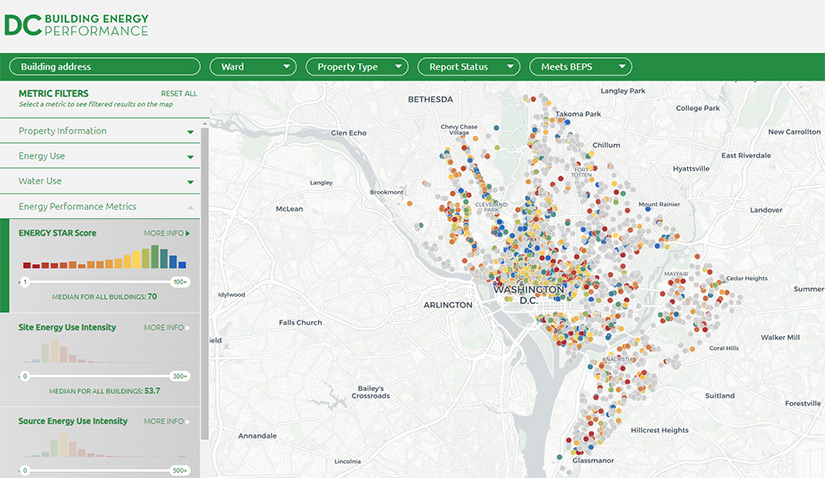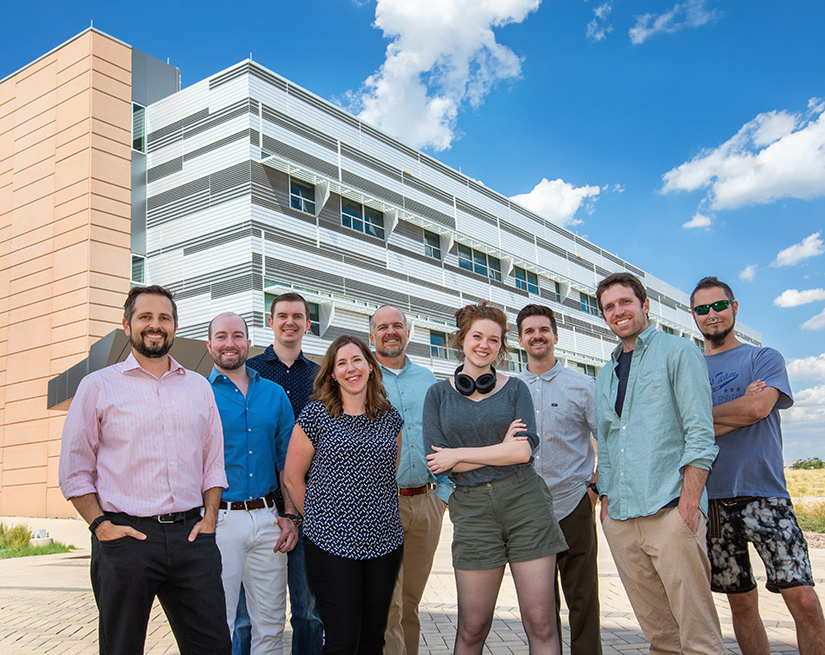Decarbonizing the Building Sector: The Devil's in the Data
NREL’s SEED Platform Wins R&D 100 Award for Giving Cities the Data Management Needed To Transform Their Building Stock

In 2018, Andrew Held was drowning in spreadsheets. He was working in Washington, D.C., helping the district’s Department of Energy and Environment implement the first building performance standard in the nation—a law that regulates the energy use of commercial buildings.
Home to famous landmarks like the White House, the U.S. Capitol, and the Washington Monument, the district also has thousands of stores, warehouses, and office buildings, some of which date back to the 1800s. District leaders knew that buildings produced three-quarters of the carbon emissions in the area. If they wanted to meet their climate goals, that is where they would need to start.
Fortunately, there was already lots of data to work with. Since 2012, Washington had been tracking the energy use of its commercial buildings under its benchmarking ordinances. But the new law required building owners to not just track their energy use but also meet certain targets—for example, if they did not achieve median energy performance, they would have to make improvements to their buildings or pay a fine. This meant Held’s office would have to collect even more data on buildings.
With new data pouring in, Held and his colleagues quickly realized they were missing something critical: a robust software tool to manage it all. They were collecting reports from 2,000 buildings, each containing more than 600 data points, using a wide variety of units and timelines. And what did they have to manage and sort all this data? Only basic spreadsheets.
“I wanted to collaborate with my colleague, but we couldn’t open the spreadsheets at the same time. It wasn’t flexible. It wasn’t dynamic. It was slow. There was no documentation. It was incredibly clunky and time-consuming,” Held said.
In 2019, Washington, D.C., started using the Standard Energy Efficiency Data (SEED) Platform, a web-based software created by the National Renewable Energy Laboratory (NREL) and Lawrence Berkeley National Laboratory to manage data from large groups of buildings. Developed hand in hand with cities to ensure it would meet their needs, the tool was a game-changer for Held’s office, saving precious time, improving the accuracy of their program, and allowing them to focus on what really mattered: helping building owners make their buildings better.
Today, SEED and other spinoffs of SEED are used in 10 jurisdictions across the United States to reduce the energy consumption and carbon emissions of their building stock, a major step toward a zero-emissions economy that earned NREL an R&D 100 Award in 2022.
“Many cities are trying to reach the White House goal of net zero emissions by 2050. They can’t each afford to create their own IT systems to do this. SEED is here and ready to help,” said Nicholas Long, a building scientist at NREL who manages the development of SEED.

SEED Tackles Information Overload With Smart Data Science
For many cities, the hardest step in creating a carbon reduction plan is the very first one: figuring out how many buildings they actually have. Their only source of information is tax assessor data, which lists parcels, not buildings. Some parcels have multiple buildings, like a university campus, for example, while other buildings straddle more than one parcel. SEED solves this problem by importing data from multiple sources, including tax lots, utility meters, and building owners, triangulating it, and generating a concise list of buildings and corresponding ownership information.
Next, SEED cleans and sorts the data so city workers do not have to do it by hand: for example, standardizing units, deleting duplicate records, and linking Year 2 data to Year 1 data. Meanwhile, automatic data quality checks “clean” the data by catching suspicious numbers, such as a month with extremely high energy usage, that could signify a faulty meter. These features were a huge time-saver for Held’s office, cutting staff time from three full-time employees to less than one full-time employee.

Providing Insights That Transform the Marketplace
You cannot change what you cannot measure—and having a detailed picture of the building stock opens a world of possibilities for city leaders. In San Francisco, for example, the city used SEED to analyze 1,700 office and retail buildings in the Bay Area and learned that many could cut their energy use in half through deep retrofits. This gave city leaders the information they needed to create budgets, policies, and incentives.
SEED also allows cities to launch carbon reduction programs quickly and with a limited budget. Not only is the SEED Platform free, but it can be easily integrated with the other software tools cities use to run their governments. Cities, for example, have linked SEED to Salesforce, a popular customer relations management tool, so they can send automated emails to building owners about their compliance status.
“SEED and these other tools can talk to each other; they can import and export data back and forth. Because we’ve been partnering with cities since the very beginning, it became obvious we needed to give them that flexibility,” said Robin Mitchell, a building researcher at Lawrence Berkeley National Laboratory who leads support for cities using SEED.
NREL recently integrated another Department of Energy program into the platform, called BETTER, that can review a building’s energy data and make specific recommendations to building owners. For example, if a building has high electricity use compared to others in the area, the tool might suggest a lighting retrofit, complete with numbers on cost and savings.
“We’re really excited about BETTER,” said Ammon Reagan, who has used SEED in both San Francisco and now Berkeley, California. “Previously we haven’t been able to give any communication back to building owners. We just take their data and tell them if they comply. With this new feature, we can tell them, ‘Based on the data you’ve provided, here are some things you could do to lower your energy use.’”
SEED was built to grow, with free code and an open-source structure that allows anyone to modify it and build on top of it to meet their needs. One company, Clearly Energy, expanded the core of SEED to create another tool enabling governments to manage their energy policies from end to end—from data management to customer relations to help-desk operations. This commercialized version of SEED is being used in 10 jurisdictions, from Cambridge, Massachusetts, to the state of Washington.
This growth is exactly what Long, Mitchell, and the other researchers had in mind when they first created SEED: that governments would embrace it and private companies would run with it.
“It creates immediate scale,” Long said, “which is what we need to do to minimize the most drastic impacts of climate change.”
Learn more about the SEED Platform and NREL Buildings research.
Last Updated May 28, 2025
